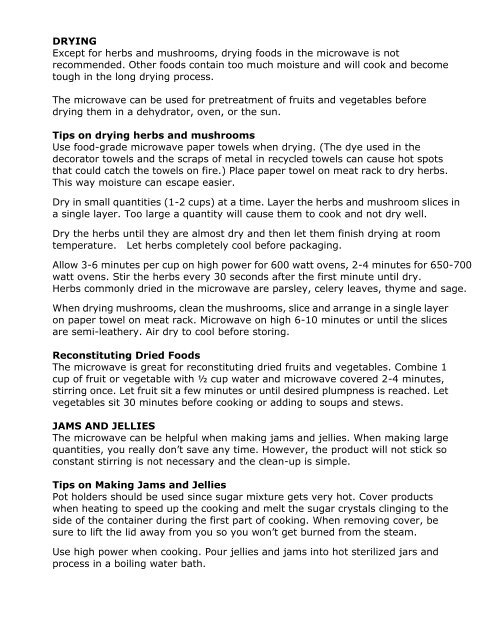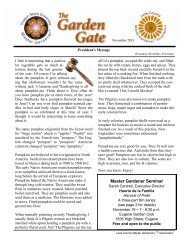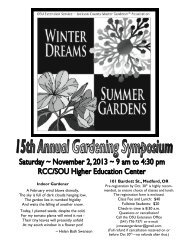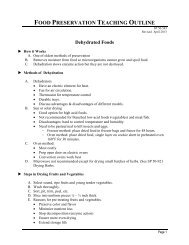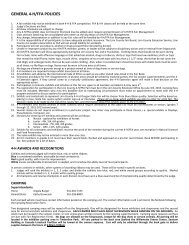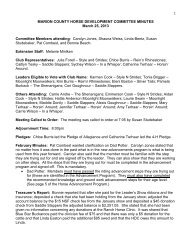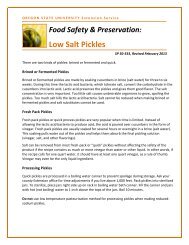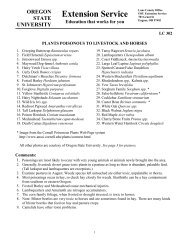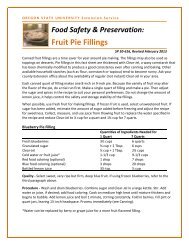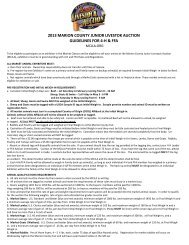Preserving Food with Help From Your Microwave (SP 50-538)
Preserving Food with Help From Your Microwave (SP 50-538)
Preserving Food with Help From Your Microwave (SP 50-538)
You also want an ePaper? Increase the reach of your titles
YUMPU automatically turns print PDFs into web optimized ePapers that Google loves.
DRYING<br />
Except for herbs and mushrooms, drying foods in the microwave is not<br />
recommended. Other foods contain too much moisture and will cook and become<br />
tough in the long drying process.<br />
The microwave can be used for pretreatment of fruits and vegetables before<br />
drying them in a dehydrator, oven, or the sun.<br />
Tips on drying herbs and mushrooms<br />
Use food-grade microwave paper towels when drying. (The dye used in the<br />
decorator towels and the scraps of metal in recycled towels can cause hot spots<br />
that could catch the towels on fire.) Place paper towel on meat rack to dry herbs.<br />
This way moisture can escape easier.<br />
Dry in small quantities (1-2 cups) at a time. Layer the herbs and mushroom slices in<br />
a single layer. Too large a quantity will cause them to cook and not dry well.<br />
Dry the herbs until they are almost dry and then let them finish drying at room<br />
temperature. Let herbs completely cool before packaging.<br />
Allow 3-6 minutes per cup on high power for 600 watt ovens, 2-4 minutes for 6<strong>50</strong>-700<br />
watt ovens. Stir the herbs every 30 seconds after the first minute until dry.<br />
Herbs commonly dried in the microwave are parsley, celery leaves, thyme and sage.<br />
When drying mushrooms, clean the mushrooms, slice and arrange in a single layer<br />
on paper towel on meat rack. <strong>Microwave</strong> on high 6-10 minutes or until the slices<br />
are semi-leathery. Air dry to cool before storing.<br />
Reconstituting Dried <strong>Food</strong>s<br />
The microwave is great for reconstituting dried fruits and vegetables. Combine 1<br />
cup of fruit or vegetable <strong>with</strong> ½ cup water and microwave covered 2-4 minutes,<br />
stirring once. Let fruit sit a few minutes or until desired plumpness is reached. Let<br />
vegetables sit 30 minutes before cooking or adding to soups and stews.<br />
JAMS AND JELLIES<br />
The microwave can be helpful when making jams and jellies. When making large<br />
quantities, you really don’t save any time. However, the product will not stick so<br />
constant stirring is not necessary and the clean-up is simple.<br />
Tips on Making Jams and Jellies<br />
Pot holders should be used since sugar mixture gets very hot. Cover products<br />
when heating to speed up the cooking and melt the sugar crystals clinging to the<br />
side of the container during the first part of cooking. When removing cover, be<br />
sure to lift the lid away from you so you won’t get burned from the steam.<br />
Use high power when cooking. Pour jellies and jams into hot sterilized jars and<br />
process in a boiling water bath.


